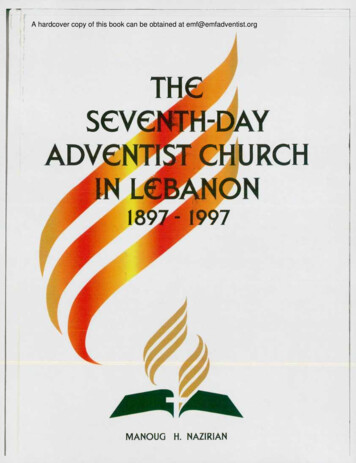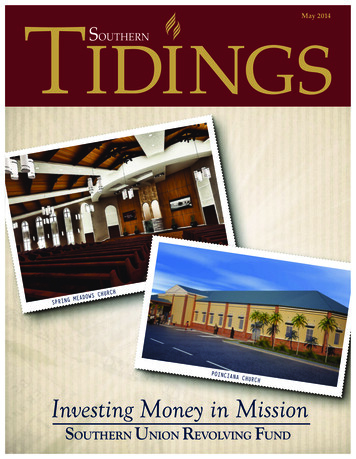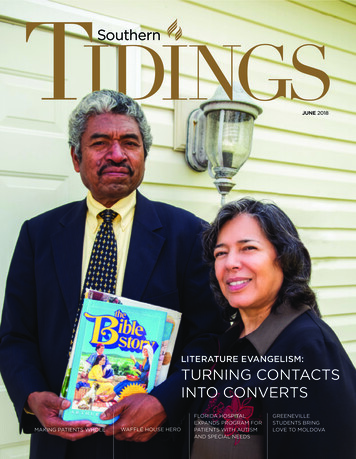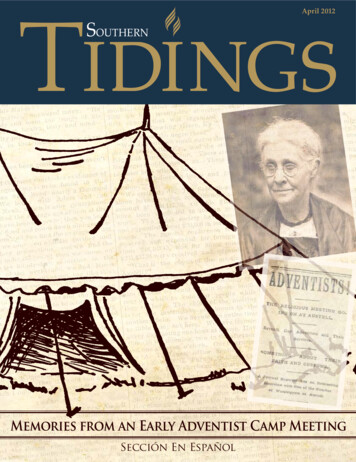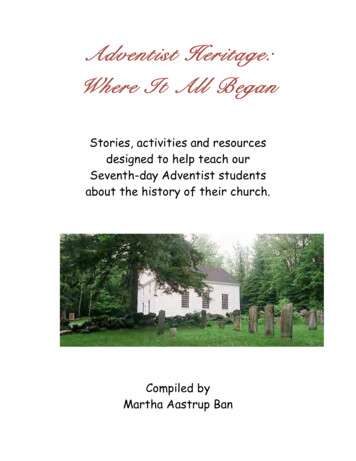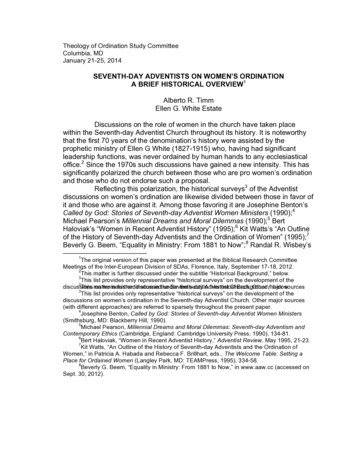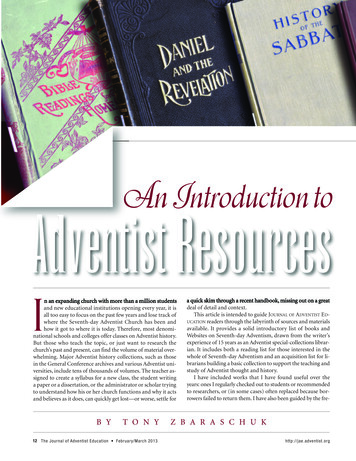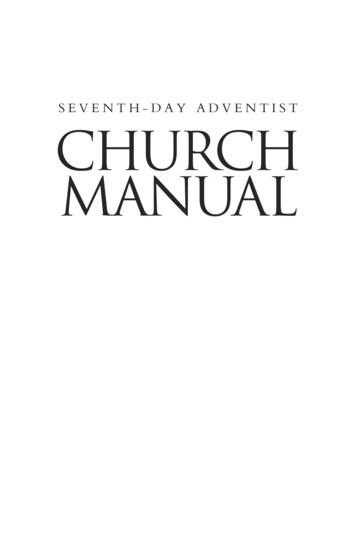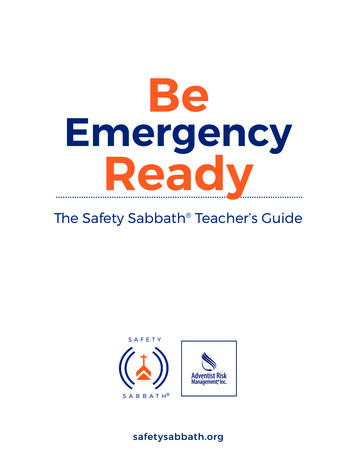
Transcription
BeEmergencyReadyThe Safety Sabbath Teacher’s Guidesafetysabbath.org
Safety Sabbath Teacher’s GuideSafetySabbath.comTable of Contents3–456–78–12SAFETYS A B B AT HHow to Protect Your Sabbath School Class During an EmergencyEmergency Preparation Key TermsParent Handout: Emergency Safety Guide for ParentsChurch Fire Drill Resources Teacher Guide: Fire Drill Guide for Sabbath School Teachers Teacher Guide: Be Ready for Church Fire Drills Activity Guide Child Activity Sheet: Two-Ways-Out Maze Parent Handout: How to Talk to Your Child About Fire DrillsFI R EDR I L L2
Safety Sabbath Teacher’s GuideSafetySabbath.comHow to Protect Your Sabbath School ClassDuring an EmergencyThere is an emergency. The fire alarm is blaring. You hear shots being fired. An urgenttext alert sounds on your phone with the message that a dangerous situation is takingplace. These are some examples of emergencies you may experience. Your job as theSabbath School teacher is to protect your class. What do you do?Emergencies place both children and adults in danger. Planning ahead and practicing will make you more effective inprotecting your class when an emergency happens.Before EmergenciesTalk to ParentsShare with parents how your class will respond to emergencies. Encourage parents to talk about emergency situationswith their children. Share the parent handouts included in this guide with parents. Explain what they can do in achurch emergency to help protect their children. Plan how you will share emergency information with visitors andwhere visiting parents can pick up their children in an emergency.Prevent Emotional StressChildren may be scared or upset by emergency situations. When helping your class get emergency-ready, discuss whatan emergency is, what types of emergencies your class may experience, and how your class will practice what to dowhen a real emergency happens. Remind the children that if they must leave their classroom, they shouldn’t takeanything with them. This can slow them down when they must hurry. Make time for children to ask questions andanswer them honestly. Be aware of which children express concerns and work with them to lessen those concerns. Praywith your class for safety for your church and all Adventist churches.Prepare for Medical EmergenciesBe aware of children who may have medical conditions. An emergency may trigger a negative response in children,and they may require medical attention. Work with your church emergency response team to plan how you willrespond to children needing care.3
Safety Sabbath Teacher’s GuideSafetySabbath.comPlan for DisabilitiesBe aware of children in your class who have disabilities or handicaps. Children in wheelchairs or using crutches willrequire additional assistance. Work with your church emergency response team to plan and practice how you willprotect and assist children who have disabilities.During EmergenciesListen to the TeacherEngage your class’s attention and tell them there is an emergency. Say: I need you to be quiet immediately and to listen tomy instructions that will help keep you safe.Follow the PlanFollow the designated plan for the type of emergency you are facing. A response plan can include evacuation,lockdown, or to shelter-in-place. Follow your Sabbath School emergency response plan, directions from your churchemergency response team, and emergency personnel. Assess the situation and modify your actions as needed toprotect the children under your care.Create your emergency response plan with your church safety committee. Determine ahead of time what your classshould do in case of emergency. Share your emergency response plan with parents, so they know where to find theirchildren following an emergency.Call 9-1-1If you are able, call 9-1-1 to report the emergency and the status of your classroom/group. Is someone injured and inneed of medical attention? Is everyone safe? How many people are in your group? Memorize your church’s address soyou can give this information to the 9-1-1 operator when reporting the emergency.After the EmergencyOnce you have protected your class through the emergency, stay with your class and return to the building or until youhave checked out each child to their guardian. Report to a member of your church emergency response team. Letthem know that everyone in your classroom returned to their guardian. Record any relevant information that canimprove your emergency response safety plan to better prepare your class for the next emergency. Share thisinformation with the church Safety Committee.4
Safety Sabbath Teacher’s GuideSafetySabbath.comEmergency Preparation Key TermsLOCK OUTGET OUTEVACUATE means to remove yourself and thoseunder your care from a dangerous situation. Toevacuate, you should leave the building with your classand go to a previously designated evacuation spot.LOCKDOWN is a state of isolation or restrictedaccess instituted as a security measure. If your churchis on lockdown, no one should enter or leave your classroom.Lock and barricade your door if necessary.SHELTER-IN-PLACE means to find shelterwithin a building and wait until the emergency haspassed. If told to shelter-in-place, find a safe locationfor your class to stay in your classroom and wait for theall-clear signal.RUN. HIDE. FIGHT. is the recommendedresponse sequence to an active shooter situation foradults. RUN means evacuate to a safe area. If you cannotevacuate, lockdown your room and HIDE by turning off lights,covering windows, and silencing all cell phones. If an activeshooter breaks into your room, the last recommended courseof action for adults is to FIGHT.TAKE OUTLOCK OUT, GET OUT, TAKE OUTis the recommended response sequence to an activeshooter situation for K–12 environments. Lock Out — In an active shooter situation, shut the doorand lock it. Hide children where they will remain unseenand where bullets cannot reach them if shot throughthe door.Barricade the door with any furniture available. Turn offlights, cover windows, silence all cell phones, and instructchildren to remain silent. Do not allow any indication ofyour presence to alert the shooter to your classroom. Donot open the door until the situation has been resolved.Some churches may elect to use a code word to alert staffwhen the situation is resolved and it is safe to come out. Get Out — If there is a safe exit, evacuate your class to asafe location. Remember, if there is a reason for thechildren to run, the group should run in a zigzag fashion,rather than a straight line. The side-to-side movementcreates a more difficult target. Take Out — This is for adults only. A teacher’s duty is tostay with their class. Other adults may choose to take outthe intruder, but teacher and students should remainhidden until safe.5
PARENT HANDOUTSafetySabbath.comBE READYEmergency Safety Guidefor ParentsAs parents, your first thought in an emergency is to secure the safety of your child.When your child isn’t with you, you must trust the trained leadership of others to keepyour child safe. Here is how to protect your child during a church emergency.1. Bring Yourself to Safety FirstIn an emergency, you should follow church emergency procedure and bring yourself to safety first. Going immediatelyto your child may be the most dangerous thing you could do. It could put both yourself and your child in more danger.Your church has a system in place to protect everyone in the building. Bring yourself to safety first.2. Follow the PlanFollow the designated emergency plan for the current crisis. The method can include evacuation, lockdown, or toshelter-in-place. Follow directions from your church emergency response team, emergency personnel, and yourpersonal emergency response plan of what you will do in an urgent situation. Just like you, your child will be followingthe emergency plan along with their Sabbath School teacher and class.3. After the Emergency, Find Your ChildAfter the crisis is resolved, and emergency personnel have announced it is safe to resume normal activity, locate yourchild at the designated checkpoint and check them out of Sabbath School into your custody. Affirm your child forfollowing directions and staying safe.6
PARENT HANDOUTSafetySabbath.comTalk to Your Child About Emergency SituationsKnowing what to do in an emergency situation is the number one thing that can keepyour child safe. Speak to your child about possible emergency situations and teachthem what to do to stay safe. The three most important lessons your child can learn inany emergency situation are:Listen to the TeacherSay: If there is an emergency, listen quietly to your teacher and do what he/she saysimmediately. You might be afraid, but try not to cry or yell. Your teacher and the other people inthe church have prepared to keep you safe.Stay AlertSay: Always pay attention to what is happening around you. If you hear, see, or feel likesomething is wrong, tell your teacher or another adult you trust. If you must leave the building,look and listen for danger and quickly move to someplace safe. If you must run, make sure yourun from side-to-side (zigzag). (Demonstrate to your child what this looks like.) Running thisway will keep you safer.Know Where Exits AreAsk: Do you know two ways out of your Sabbath School classroom? If there is an emergencyand one exit is blocked, do you know another way to get out of the room?By preparing your children ahead of time for emergency situations, you will be confident that they will not panic andwill be more aware of their safety and how to keep others safe from harm until you are safely reunited.STAY INFORMEDADVENTISTRISK.ORG/SOLUTIONSAdventist Risk Management, Inc. 2017THIS MATERIAL IS FACT BASED GENERAL INFORMATION AND SHOULD NOT, UNDER ANY CIRCUMSTANCES, BE CONSIDERED SPECIFIC LEGAL ADVICE REGARDING A PARTICULAR MATTER OR SUBJECT. PLEASECONSULT YOUR LOCAL ATTORNEY OR RISK MANAGER IF YOU WOULD LIKE TO DISCUSS HOW A LOCAL JURISDICTION DEALS WITH ANY SPECIFIC CIRCUMSTANCES YOU MAY BE FACING.7
Safety Sabbath Teacher’s GuideSafetySabbath.comSAFETYS A B B AT HFIREDRILLBe Readyfor Church FiresDRILL RESOURCES FOR SABBATH SCHOOL TEACHERS8
Safety Sabbath Teacher’s GuideSafetySabbath.comSAFETYS A B B AT HFire Drill Guide for Sabbath School TeachersFIREDRILLBefore the DrillDuring the DrillHolding safety drills can create risks for your class. Planwith your church Safety Committee and Safety Officer onwhat your class should do if the training is conductedduring Sabbath School.1. When the fire alarm sounds, explain to your class thata fire drill is in progress. Tell them you need them tobe silent and listen to you at all times as you tell themwhat to do to keep them safe.Prepare ParentsTell parents to anticipate a drill and explain why it isimportant. Share the How to Talk to Your Child About FireDrills Parent Handout that outlines the material you plan togo over with their children. Encourage parents to discusswith their children at home what a fire drill is and how torespond to a fire emergency. On the Sabbath before thedrill, give parents the Emergency Safety Guide for Parentshandout when they check their child in for Sabbath School.2. Tell your class that, just like you planned earlier, it istime to evacuate. Teach the children to feel doors forheat before opening doors and to look down hallwaysfor fire or smoke before exiting the room. Lead yourclass from the building to your designated spotoutside and away from the building.Prepare Your ClassChildren may be scared or upset by a safety drill. Say: Wehold safety drills to help us be ready if a real emergency happensand everyone can stay safe. Go over what the children canexpect during the training, so they feel prepared toparticipate. Remind the children that if they must leave theirclassroom, they shouldn’t take anything with them. This canslow them down when they must hurry.Use the Be Ready for Church Fire Drills Activity Guide toexplain what “evacuation” means and the importance ofgetting out quickly and safely. Plan with them how theyshould respond to the fire alarm, including helping anyclassmates with physical disabilities.3. Once your class has evacuated to safety, tell thestudents that if this were a real emergency, nowwould be when you would call 9-1-1 and report theemergency.4. Once the all-clear signal sounds for the drill, have yourclass return to their classroom. Explain that in a realemergency, your class would remain outside untiltheir parents check them out or emergency personnelclears the building for re-entry.After the DrillChildren may be scared or upset by an emergency drill.Remind them that we hold safety drills so when a realemergency happens we can all stay safe. Pray with yourclass for safety for your church and all Adventist churches.9
Safety Sabbath Teacher’s GuideSafetySabbath.comSAFETYS A B B AT HFIREDRILLBe Ready for Church Fire DrillsSabbath School Activity GuideUse this guide to plan appropriate activities for the age range of your class.1. Have children share what the words “safety” and“danger” mean.Safety—protected from or not exposed to danger orrisk; not likely to be harmed or lost.Danger—the possibility of suffering harm or injury.6. Have children write down or draw things that cancause a fire in a church.Examples: damaged electrical wires, overloadedoutlets, stove or oven fires, candles.7.2. Have children list some of the hazards that comefrom a fire.Examples: burns, smoke inhalation.3. Have children share what a “safety drill” is, and whyyour church holds safety drills.Suggested answer: When there is an emergency,everyone will be ready to prevent bad thingsfrom happening.4. Demonstrate with children how your class willevacuate quietly and quickly if there is a fire. Leadthem to the safe place where your class will meet.5. Have the children talk about why they must leavethings behind when they leave the classroom.Encourage them to discuss how that will makethem feel.Have children identify two exits from their classroomand two exits from the church building. If yourclassroom does not have two exits, plan with yourclass what you will do if you are not able to evacuate.8. Teach children how to escape from a second (orhigher) floor when blocked by fire. Review how toprevent smoke from entering the room by usingmaterials to fit under the crack of the door.9. Demonstrate how to test if there is fire behindclosed doors by touching the door and doorknobfirst to check if it feels hot.10. Teach children how to crawl on the ground toprevent smoke inhalation.11. Give the children the “Two Ways Out Maze” tocomplete.10
ACTIVITY SHEETSafetySabbath.comTwo-Ways-Out MazeWhen doors or hallways are blocked during an emergency, you will need to find another wayto escape. Always know two ways to get out of every building. Can you help this person findtheir way out of the room through the maze of danger?11
PARENT HANDOUTSafetySabbath.comSAFETYS A B B AT HFI R EDRILLHow to Talk to Your Child AboutFire Drills—A Guide for ParentsIn the event of a church fire, your child’s Sabbath School Teacher will evacuate your child and theirclass to a safe designated checkpoint outside the church building. Here are the evacuation steps youcan review with your child before the fire drill so your child is ready to participate and learn how tostay safe during a real fire.Tell your child:Soon, our church will have a fire drill. A drill is when wepractice what to do if our church catches on fire. During thetraining, we will pretend that our church is on fire. We need toact quickly to stay safe and not get hurt. Here is what youshould do.LISTEN—During the drill always listen to your teacher anddo what they say. Listening carefully and obeying what yourteacher says will help keep you safe.EVACUATE—If the building is on fire, you need to leave thebuilding and go outside. You will be safe there. Don’t takeanything with you. If you carry something, it will slow youdown. Things can be replaced. You cannot be replaced. Iwant you to keep you safe. Your teacher will tell you whichexits to use and where to go. If you see fire or smoke ahead,tell your teacher right away. If there is a lot of smoke and youare having trouble breathing, get down on the floor andcrawl as fast as you can to the exit. Smoke from a fire rises tothe ceiling, so it will be easier for you to breathe if you crawlalong the floor.WAIT—Your teacher will tell you where you can find youroutside evacuation checkpoint. That is the place you shouldgo after you get out of the building. When you get to thecheckpoint, wait until your teacher tells you it is safe to goback inside or until Mommy or Daddy come to pick you up. Ifyou get separated from your teacher, keep going to thecheckpoint and wait there until the teacher, Mommy orDaddy, or emergency personnel like a firefighter or policeofficer tell you what to do.Ask: After you leave your classroom, where will you go toand what will you do when you get there?NOTE TO PARENTSYour church will have a designated checkpoint for you to pickup your children. Ask your child’s Sabbath School teacher forthe checkpoint location.Children may be scared or upset by an emergency drill.Remind them not to panic. Say: Safety drills help you learn howto stay safe when a real emergency happens. Pray with your childfor safety for your church and all Adventist churches and that ifanything bad happens, they will be ready and stay safe.Please be prepared to participate in our church’s upcomingsafety drill and keep our church family and visitors safe!Ask: After you leave your classroom, where will you go to andwhat will you do when you get there?12
ARM CARESAt Adventist Risk Management, Inc., our ministry is to protectyour ministry. Use the resources online at AdventistRisk.org tohelp protect your facility and those under your care.REPORT YOUR CLAIM RIGHT AWAY1.888.951.4276 CLAIMS@ADVENTISTRISK.ORGSTAY INFORMEDADVENTISTRISK.ORG/SOLUTIONSAdventist Risk Management, Inc. 2017THIS MATERIAL IS FACT BASED GENERAL INFORMATION AND SHOULD NOT, UNDER ANY CIRCUMSTANCES, BE CONSIDERED SPECIFIC LEGAL ADVICEREGARDING A PARTICULAR MATTER OR SUBJECT. PLEASE CONSULT YOUR LOCAL ATTORNEY OR RISK MANAGER IF YOU WOULD LIKE TO DISCUSS HOWA LOCAL JURISDICTION DEALS WITH ANY SPECIFIC CIRCUMSTANCES YOU MAY BE FACING.
LOCKDOWN is a state of isolation or restricted access instituted as a security measure. If your church is on lockdown, no one should enter or leave your classroom. Lock and barricade your door if necessary. SHELTER-IN-PLACE means to find shelter within a building and wait until the emergency has passed. If told to shelter-in-place, find a safe .
